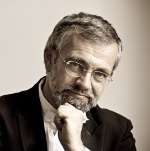The Emerson String Quartet is one of the most stable chamber music ensembles in the world. In the course of their illustrious career, spanning over four decades, they only had one change in membership: in 2013, Welsh cellist and renowned conductor, Paul Watkins, replaced David Finckel. The programme in which Watkins was introduced to the world as member of the quartet was very similar to the first Sydney concert of this eight-city tour of Australia, featuring the music of Haydn, Bartók and Beethoven. Unlike that festive occasion, however, this performance was disappointing in several ways.
From the slow introduction to the first movement of Joseph Haydn’s String Quartet in D major, Op.71 no.2, the Emersons’ overall musical concept seemed lacking in energy. The brilliant vitality of Haydn’s music could not break through the narrow range of dynamic changes and uninspired fast passages of the Allegro. True, their homogenic, well-balanced sonic atmosphere was pleasing, but this only exposed the frequently vague intonation of the first violin in the high solo passages. The slow movement was peaceful, though nowhere near as cantabile as the composer’s instruction might imply. The characteristic Haydn wit of introducing an already unusual, ten-bar long theme at the beginning of the Menuetto, only to drop its first, introductory bar later and thus truncate the phrase, sounded ordinary, rather than surprising, and the numerous off-beat accents in the Finale were too tame to save the movement from becoming soporific.
Next came the String Quartet no. 5 by Béla Bartók, in which perfectly formed, arc-like symmetry meets an army of jarring dissonances; a brutal portrayal of the modern world is juxtaposed with quiet whispers of the night, as are asymmetrical dances with parodistically simple melodies (significantly, this composition was written in 1934). The persistent bark-like ostinato that this composition begins with is agitated in the extreme and from that point on, in a good performance, the audience should constantly be on edge.
The first movement was performed professionally, well together, with fine balance and unified vibrato. Only the harsh edges were missing, so deliberately composed and marked by Bartók; for example, in the colossal increase of tension and volume between the first and second sounding of the opening theme. The quiet, chromatic third subject works best if it is offset by aggressive, unexpected accents around it, but in this performance, those differences were not always explored.
The intricate rhythmic patterns of the Scherzo were safely followed, even if, with more daring leadership, the Eastern European metrical spices could have infiltrated this wild dance more. I enjoyed the chirping, almost hesitant beginning of the following Andante movement, but later, this lovely atmosphere was disturbed by unsettled intonation in the upper three instruments. Problems of this nature occurred briefly, but often enough to give reason for concern.
The Emerson Quartet is one of the few quartets in the world where the two violinists share the leading role. Opting for this arrangement is a decision needing courage, as it assumes that both musicians are equally capable of leading the group and acting as a supportive voice. Eugene Drucker, who played first violin in the first half of the concert, swapped with his colleague, Philip Setzer, for the performance of Beethoven's String Quartet no. 8 in E minor, "Razumovsky", Op.59 no.2, after the interval.
This was a welcome change. The musical attitude of the ensemble seemed to change into an energised, truly engaged group of four players. The considerably greater contrasts (dynamic or otherwise), initiated by Setzer, were taken up by the others with zest and ease. This worked well in the extensive slow movement, where the musicians took Beethoven’s words to play with a lot of emotion (con molto di sentiment) seriously. The sublime, chordal beginning, hinting already at the depth of the late Beethoven quartets, with its gentle vibrato and finely integrated sound was particularly appealing. Unfortunately, in the next movement, especially in the Russian theme of the middle section, the violins and the viola (Lawrence Dutton) again struggled with intonation problems. In our times, when conservatories and international chamber music competitions produce new generations of excellent chamber ensembles with reliable regularity, a well-established, internationally recognised quartet has little excuse for such shortcomings.
The triumphant passion of the Finale was there only in traces. The cellist kept constant eye contact with his colleagues and the joy of playing was obvious on his facial expression; however, the overall impression of this movement was akin to a joke that has been told too many times.




